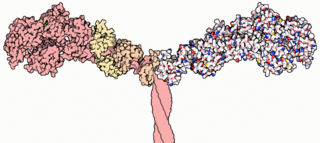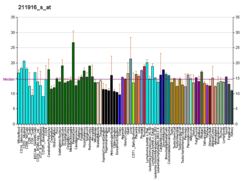
Myosins are a superfamily of motor proteins best known for their roles in muscle contraction and in a wide range of other motility processes in eukaryotes. They are ATP-dependent and responsible for actin-based motility.

Myosin VIIA is protein that in humans is encoded by the MYO7A gene. Myosin VIIA is a member of the unconventional myosin superfamily of proteins. Myosins are actin binding molecular motors that use the enzymatic conversion of ATP - ADP + inorganic phosphate (Pi) to provide the energy for movement.

Melanophilin is a carrier protein which in humans is encoded by the MLPH gene. Several alternatively spliced transcript variants of this gene have been described, but the full-length nature of some of these variants has not been determined.

Unconventional myosin-Va is a motor protein in charge of the intracellular transport of vesicles, organelles and protein complexes along the actin filaments. In humans it is coded for by the MYO5A gene.

Tropomyosin alpha-1 chain is a protein that in humans is encoded by the TPM1 gene. This gene is a member of the tropomyosin (Tm) family of highly conserved, widely distributed actin-binding proteins involved in the contractile system of striated and smooth muscles and the cytoskeleton of non-muscle cells.

Unconventional myosin-VI, is a protein that in humans is coded for by MYO6. Unconventional myosin-VI is a myosin molecular motor involved in intracellular vesicle and organelle transport.

WAS/WASL-interacting protein (WIP) is a protein that in humans is encoded by the WIPF1 gene.

MYO9B is a gene that encodes the Myosin-IXb protein.

Myosin-Ic is a protein that in humans is encoded by the MYO1C gene.

Myosin X, also known as MYO10, is a protein that in humans is encoded by the MYO10 gene.

Myosin-14 is a protein that in humans is encoded by the MYH14 gene.

Myosin-XVIIIa is a protein that in humans is encoded by the MYO18A gene.

Myosin-Vb, a myosin V type protein, is encoded by the MYO5B gene in humans.

Myosin-IIIa is a protein that in humans is encoded by the MYO3A gene.

Myosin-Ib is a protein that in humans is encoded by the MYO1B gene.

Myosin-If is a protein that in humans is encoded by the MYO1F gene.

Myosin-XVIIIb is a protein that in humans is encoded by the MYO18B gene.

Myosin-Ie (Myo1e) is a protein that in humans is encoded by the MYO1E gene.

Myosin-XV is a protein that in humans is encoded by the MYO15A gene.

Espin, also known as autosomal recessive deafness type 36 protein or ectoplasmic specialization protein, is a protein that in humans is encoded by the ESPN gene. Espin is a microfilament binding protein.


















